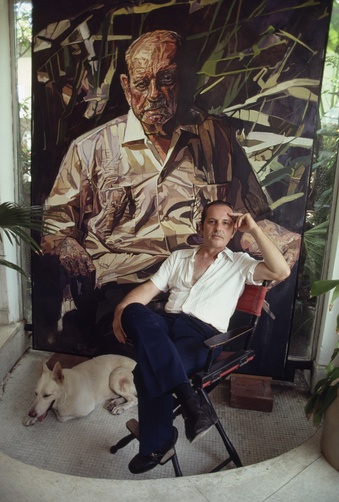Yesterday was the 25th of July, el Día de la Constitución en Puerto Rico (Constitution Day). It is a big holiday very much like the 4th of July in the US. We began it going to the funeral mass of, get this, the brother of the husband of the sister of Laura’s father. You get that? It all boils down to el hermano del querido tío Benny. I call him Tío Benny too. We always gravitate towards each other during family functions and end up talking compost and farming and whatnot. I’ve learned a lot from him. So when we heard his brother had died, it was a given that we would be there.
This is how Puerto Rico is. Cousins removed – cousins of cousins, cousins through marriage… they’re all primos and we all celebrate and share together. I sometimes feel like an outsider, but still, I appreciate watching and pretending. I suppose it’s as close as this gringo can get.
The funeral mass was held for Pedro Alberto, a local school director and beloved character in the town of Guayama in the southeast of Puerto Rico. The mass was packed, the homely strange, and the words spoken few, but everyone was there, extended relatives from all branches. My wife’s parents were there. We were there with our four children.
As is my usual manner, I contemplated my place in the assembly, the upsides and the downsides. On the general downside of having a huge interconnected family, we attend a lot of funerals. There are so many extended relatives, you just can’t help but be called upon to go and show support. It’s not pleasant, certainly. Who wants to face their own mortality, be reminded of it regularly. Can’t we all pretend that life just goes on forever?
For the kids too, do we really want them to be here? Is it too hard? I don’t think it is, in fact, I think it’s good for them. It is probably good to be exposed early, to get to know pain and mourning and the loss of a loved one, because it will find them later in life, and they should be accustomed to the process. “Javier, this is the mass for Tio Benny’s brother. I’m sure he misses him. You would be so sad if you lost one of your brothers, no?” Yes, he said, and I know he appreciates his brothers. They all hugged each other and gave each other kisses. Such cariño; it brought a tears to my eyes.
There’s an upside too, more in line with my previous post about beauty and pain. Life is beauty and pain. Living is painful, but life is beautiful. A funeral mass is the acknowledgement of that duality. There is relief for the dead; the long journey is over. There will be no more tears to cry, no more pain to endure. You are dead, you finished your work. For the living, the frailties of the departed loved one become less important as time passes, until la vida is purely sanctified and beautiful.
This mass, this ritual is the coming together to process and find acceptance, to deal with the passing and in the end to say, “It’s all good.”
When it was over, I was tired, but at peace. I thought it fitting that we celebrated this Constitution day doing something important, something that I feel is the best part of the Puerto Rican culture, la familia.
We have passed from religion, to family, and now we finish with another typical and important part of Puerto Rican culture. I will leave it here so that we end on a light note with our bellies full and smiles on our faces.
We stopped in Guavate and ate lechón, slow cooked pig on a spit, with rice and gandules, mofongo, amarillos, yuca y morcilla.
From family and religion to the tasty pig, it doesn’t get more typical than that.
